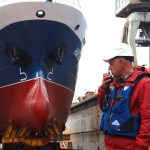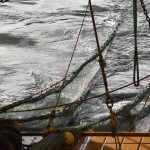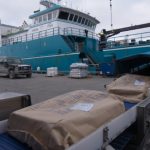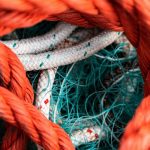In a postal vote NEAFC has adopted measures that close more than 330,000 square kilometres to bottom fisheries on the Mid-Atlantic Ridge, an area larger than the size of UK and Ireland combined.
This comes on top of a number of other measures adopted by NEAFC to protect deep-sea diversity. These measures are summarised below. The closures are shown on the map below.
The five green areas on the Mid-Atlantic ridge are the closures adopted this month. The red line is the boundary of the high sea areas in the North East Atlantic. The “new” fishing areas are the areas outside the white lines in the north east corner (the Hatton – Rockall Banks area, of the high seas area).
Commenting on these developments, NEAFC President, Mr Stefán Ásmundsson (Iceland), said: In adopting this proposal NEAFC has responded to calls from the UN General Assembly and agreed a balance between conservation and utilisation and, in a holistic, integrated process respecting the precautionary and ecosystem approach, secured the participation of those stakeholders that are affected by the measures adopted. The organisation has once again demonstrated that it is possible to reach agreement on difficult issues.
SUMMARY OF ACTIONS TAKEN BY NEAFC TO PROTECT VULNERABLE MARINE ECOSYSTEMS IN THE HIGH SEAS OF THE NORTH EAST ATLANTIC
The need to protect vulnerable deep-sea habitats and species has been high on the NEAFC agenda in recent years. During this period NEAFC has requested scientific information and advice on vulnerable deep-sea habitats. This has not been available in a number of instances, pending more research. It is well known that the current science surrounding temperate area closures is uncertain. Consequently NEAFC has moved forward in a precautionary and adaptive manner.
The amendments to the NEAFC Convention and the London Declaration in 2006 created the formal basis for taking action, but NEAFC had already closed an area in the Rockall Area to protect juvenile fish in 2002 and in 2004 NEAFC banned bottom fishing in a large area on the Reykjanes Ridge (the northern part of the Mid-Atlantic Ridge) and four seamounts adjacent to the Ridge.
In 2007 NEAFC prohibited bottom fishing in five areas in the Rockall – Hatton Bank area to protect deep-water corals.
The NEAFC Permanent Committee on Management and Science, PECMAS, has adopted procedures to consider proposals for further closures. An important element is the scientific evaluation of proposals by NEAFC’s provider of scientific advice, the International Council for the Exploration of the Sea, ICES.
Earlier NEAFC agreed to reduce effort in all deep-water bottom fisheries by 35 %.
NEAFC has prohibited fisheries with gillnets, entangling nets and trammel nets in depths below 200 m and introduced measures to remove and dispose of unmarked or illegal fixed gear and retrieve lost gear to minimise ghost fishing.
In July 2008 NEAFC adopted additional measures on bottom fishing activities in the NEAFC Regulatory Area. These were supplemented at its 2008 Annual Meeting with specific operational procedures. There are now clear procedures and rules in place on how to identify existing bottom fishing areas, exploratory fishing in new bottom fishing areas, how to assess bottom fishing activities, how to deal with encounters with vulnerable marine ecosystems and data collection protocols for observers onboard fishing vessels to increase knowledge of vulnerable habitats in deep waters.
In this regard, the NEAFC Contracting Parties recognise the importance of dialogue and collaboration with responsible fisheries operators and the value of industry information and experience in responsible fishing techniques, gear development, and implementation methods to avoid or mitigate significant adverse impacts on VMEs.
As mentioned, above scientific information has not been available to the extent NEAFC would have wished. Assessment of the risk of significant adverse impacts on bottom fishing activities will be an ongoing process. The work in 2008 represented what can be done with the information and resources available. However, NEAFC has continued its assessments beyond 2008 as information and experience grows.
Procedures for assessment have been brought into place and each Contracting Party is required to assess impacts for any proposed bottom fishing in 2009. The conclusion of the preliminary assessment is that current bottom fisheries practices in the NEAFC Regulatory Area do not have significant adverse impacts on VMEs.
Moreover, in April 2009 NEAFC decided to close five areas on the Mid-Atlantic Ridge in the high seas in the North East Atlantic to bottom fisheries under its policy for area management. A map of the full extent of the NEAFC closures is attached.
Pursuant to the competence of NEAFC, this implies that fishing activities by vessels flying the flags of NEAFC Contracting Parties or Co-Operating Non-Contracting Parties, with fishing gear which is likely to contact the seafloor during the normal course of fishing operations, are prohibited within these areas.
A proposal tabled in June 2008 has formed the basis of discussions in NEAFC. NEAFC hasreceived advice on this proposal from ICES, which has assessed the proposal against the standards and criteria for identifying vulnerable marine ecosystems (VME), developed by the UN’s Food and Agriculture Organisation (FAO) in response to the United Nations General Assembly resolution 61/105 to support the sustainable management of deep-sea fisheries and responsible fisheries in the marine ecosystem.
These new area closures include all five areas which were closed on a temporary basis in 2004. The combined size of the closed areas is estimated at 333,000 km² covering a large portion of the Mid-Atlantic Ridge, an area larger than the United Kingdom and the Republic of Ireland combined.
Moreover, the remaining part of the mid-Atlantic Ridge is at present regarded as a “new fishing area” in the context of the recommendation regulating bottom fishing activities in the NEAFC Regulatory Area, NEAFC Recommendation XVI:2008, and consequently a series of precautionary measures applies to potential bottom fishing operations as set out in NEAFC Recommendation VIII:2009. The size of the “new fishery” area may change as we receive fisheries activity data for all Contracting Parties later this year.
The two permanent Committees of NEAFC, the Permanent Committee on Control and Enforcement and the Permanent Committee on Management and Science, have been asked to consider thresholds of catches of live corals and sponge and move-on provisions, based on scientific advice from ICES, and will report to the 28th Annual Meeting of NEAFC in November 2009.
NEAFC is confident that it is well prepared to meet all requirements in international law, technical guidelines adopted in FAO and the objective of its own Convention.









